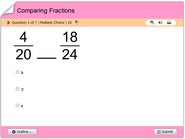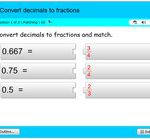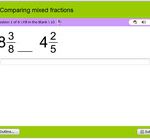Comparing equivalent fractions quiz
Learn Math Comparing equivalent fractions exercise with online quiz.
Math quiz on comparing equivalent fractions
Math quiz on comparing equivalent fractions. Children will through this quiz understand how to find numerators and denominators of equivalent fractions. This quiz makes makes the notion of equivalent fractions easy to understand. This activity is a review option for kids in 3rd, 4th, 5th, 6th and 7th grades. Have fun with comparison of equivalent fractions.
When we compare equivalent fractions, we are determining which one is greater or smaller than the other. Equivalent fractions are fractions that have the same value, even though they might have different numerators and denominators.
To compare equivalent fractions, we can start by simplifying the fractions to their lowest form. To simplify a fraction, we find the greatest common factor (GCF) of the numerator and denominator and divide them both by it. For example, 4/8 and 1/2 are equivalent fractions because they are both simplified to 1/2.
Another way to compare equivalent fractions is by cross-multiplying. This method compares the products of the numerators and denominators, instead of just the numerators or denominators.
For example, let’s compare 2/3 and 4/6:
Cross-multiply 2/3 and 4/6, We get (26) and (34) which equals to 12 and 12, therefore the product of the numerator and denominator of the 2 fractions are equal.
We can also compare the fractions by thinking about it as parts of a whole. If we have a whole pizza and want to split it into 8 pieces, we can represent it as 8/8, or 1. Now if we want to split the pizza into 16 pieces instead, we can represent it as 16/16 or 1 as well. Even though they are represented as different fractions, they are both the same, because they both represent the entire pizza.
It’s also important to remember that equivalent fractions can be found by multiplying or dividing both the numerator and denominator by the same number. For example, 2/3 is equivalent to 4/6, because if we multiply both the numerator and denominator of 2/3 by 2, we get 4/6.
In conclusion, comparing equivalent fractions is easy, because they have the same value. We can compare them by simplifying the fractions to their lowest form, cross-multiplying them, or thinking about them as parts of a whole. It’s also important to remember that equivalent fractions can be found by multiplying or dividing both the numerator and denominator by the same number.
Practicing comparing equivalent fractions is a great way to become more familiar and comfortable with this concept. Encourage kids to practice with different fractions and different methods to become confident and comfortable with comparing equivalent fractions.



